National Water
Monitoring Day 2002:
Monitoring in Mississippi
The Clean Water Act and the North American Native Fishes Association were
both started in 1972! Friday 18 Oct 2002 was
National Water Monitoring Day, in which volunteers
across the United States tested local waters (especially those not
regularly monitored by state and federal agencies)
so that areas of degraded water quality can be
identified and delineated on a national scale. We urge all interested
members of NANFA to read about and participate in this worthwhile
effort:
www.yearofcleanwater.org/events/volunteer.htm This
could also be a great excuse to organize a field trip, collect some
fish, and, possibly, begin our own tradition of annual fish-habitat
surveys.
Test kits cost $16.50 and are available through the Year of Clean Water
website. These kits allow volunteers to test dissolved oxygen, pH,
water clarity (i.e., Secchi transparency), and
temperature up to 50 times. The kits are easy to use
and recommended for ages "8 and up." The NANFA BOD has
indicated that it may be able to help defray cost of test kits for
reps/members that choose to participate. Use of this particular test
kit, however, is not required. You can use other
test kits or water quality probes.
Sampling sites are registered online, and it is easy.
You just click on the map of the US until you find
your water body, enter the latitude and longitude
(it changes as you click on the map), and then
provide some background information (where you will sample, name of stream,
etc.). It only takes a few minutes.
Also, the date is symbolic. Data will be accepted if they are
collected any day during the period 12-27 October.
Here are some photos from the Mississippi Region's efforts:
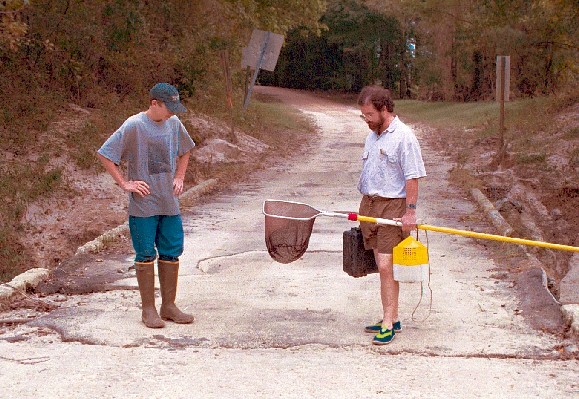
Despite raging rivers and gloomy skies, NANFA members Martin Moore (right),
Tyler Strange (left), and Jan Hoover (not pictured) met Sunday afternoon,
13 Oct 2002, at Utica, Mississippi to sample habitat and fishes as part of
National Water Monitoring Day. Equipped with various meters, wading rods,
dipnets, and seines, they visited three locations in the upland streams of
the White Oak system (Bayou Pierre Drainage).
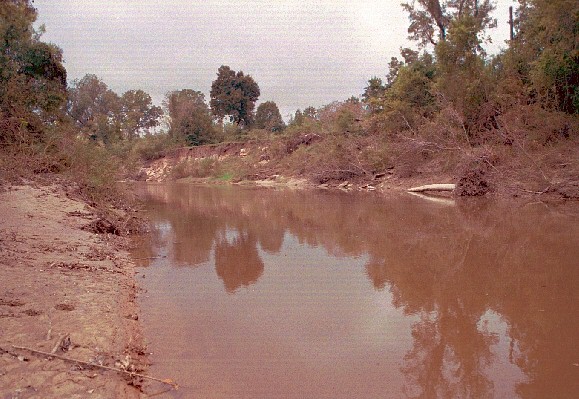
The first locality was lower White Oak Creek at Highway 18. Erosion was
evident by the steep, high banks, and the stream bottom was silty and
unconsolidated. Fish were not sampled but water quality was recorded.
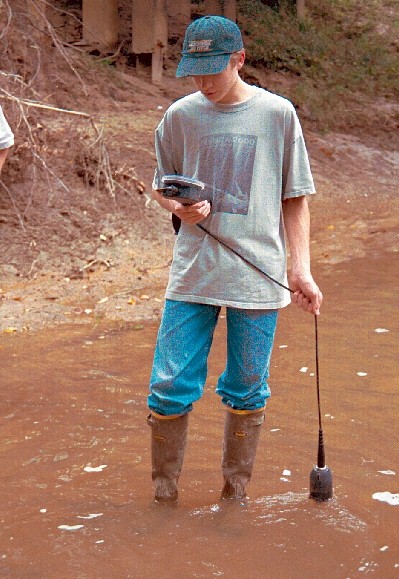
A Hydrolab multi-parameter water quality probe was used to measure water
temperature, pH, and dissolved oxygen. Tyler watched the display
continuously to see when dissolved oxygen readings stabilized. A Hach 2100P
turbidimeter was used to measure turbidity, or opaqueness of the water.
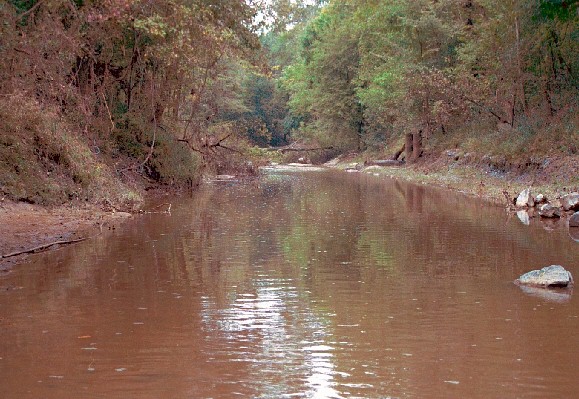
Tallahalla Creek at Highway 27, the second locality, was more inviting to
fish enthusiasts. Banks were stable and substrates were a mix of firm mud,
sand, and gravel. The introduced Asian clam, Corbicula, was abundant in
patches.
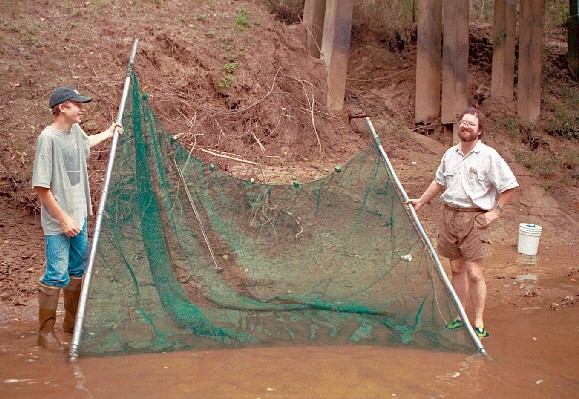
Fishes were collected principally be seining. The seine used was 8 X 10 ft,
3/16 inch mesh, which is small enough for kicksets in shallow water, high
enough for sweeping deep pools, and coarse enough to let recently spawned
(and mostly unidentifiable) young-of-year pass through.
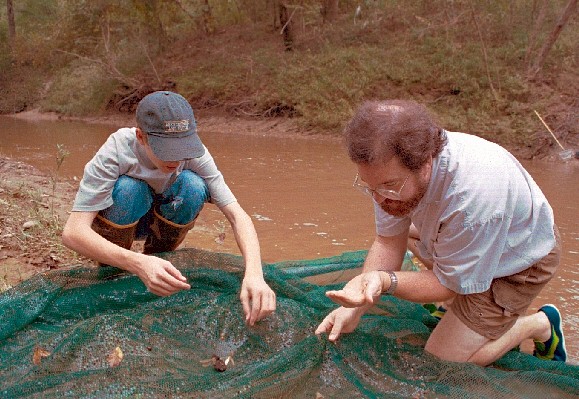
Quantitative samples were not taken. Instead, most fish were released
immediately after capture, some were retained alive for a native fish
aquarium, and a few voucher specimens were preserved. A species list was
compiled, though, with notes on relative abundance. Common species here
were longnose shiner (Hybopsis longirostris), bluntface shiner (Cyprinella
camura), and blacktail shiner (C. venusta). Uncommon but notable was the
silverjaw minnow (Erycimba buccata).
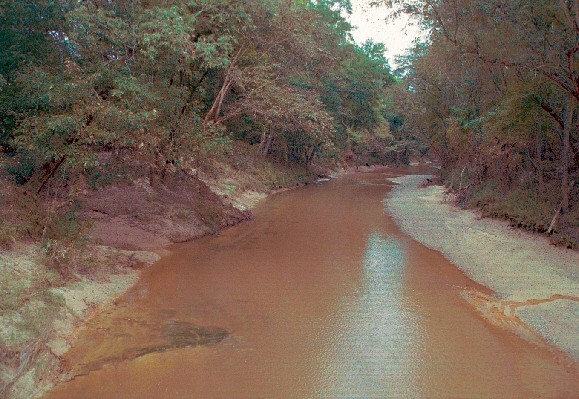
The third locality, upper White Oak Creek at Low Water Bridge Road, has been
sampled by Jan and his co-workers at Waterways Experiment Station annually
since 1994.
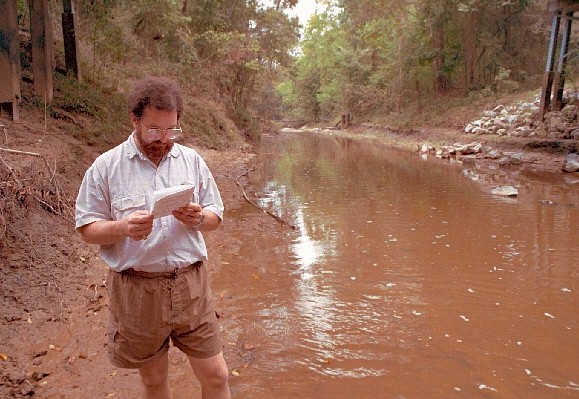
Martin reviewed the species lists compiled for recent years and wondered at
the apparent lack of sand darters (Ammocrypta spp.).

A tiny tributary consisting of deep pools, waterfalls, and narrow runs,
emptied into the stream. This tributary was inhabited by southern striped
shiner ( Luxilus chrysocephalus), sunfishes (Lepomis spp.), central
stoneroller (Campostoma anomalum), and a chubsucker (Erimyzon sp.). The
main channel was shallow, and consisted of riffles, runs, glides, pools, and
undercut banks. Unusual were specimens of the least
madtom (Noturus
hildebrandi) comparable in abundance to the brindled madtom (N. miurus).
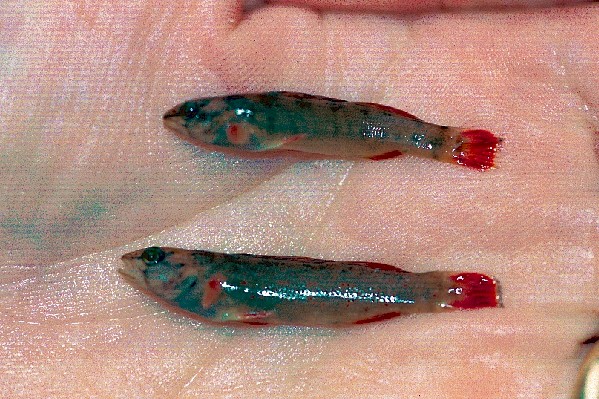
The most notable find of the day, however, was the bayou darter (Ethe ostoma
rubrum) collected at Tallahalla and White Oak Creeks. This species is
endemic to the drainage, and is listed as an endangered species, although
some observations indicate that it is expanding its range. These
specimens, collected at dusk, were a little ambiguous. They lacked the
white cheek and very distinct teardrop and paired caudal spots
characteristic of the bayou darter, but showed caudal "smudges," a creamy
band at the base of the caudal fin, and intense red pigmentation.
Todd Slack and Scott Peyton, at the Mississippi Museum of
Natural Science, examined this photo and confirmed that these were
bayou darters .
| 








